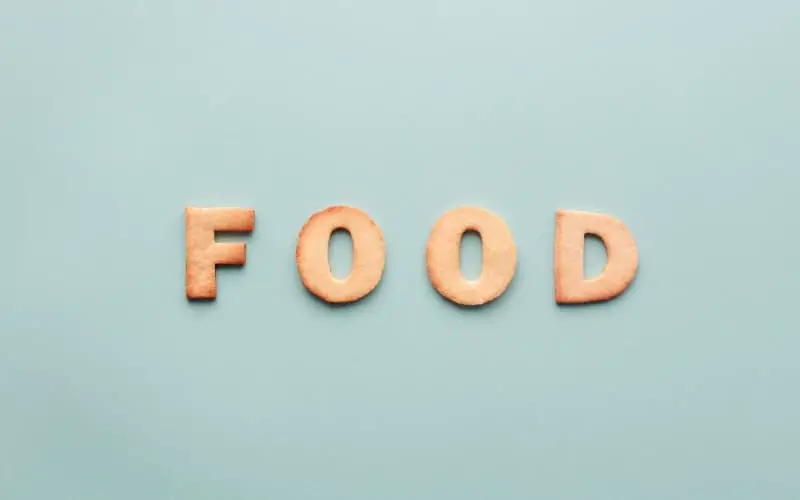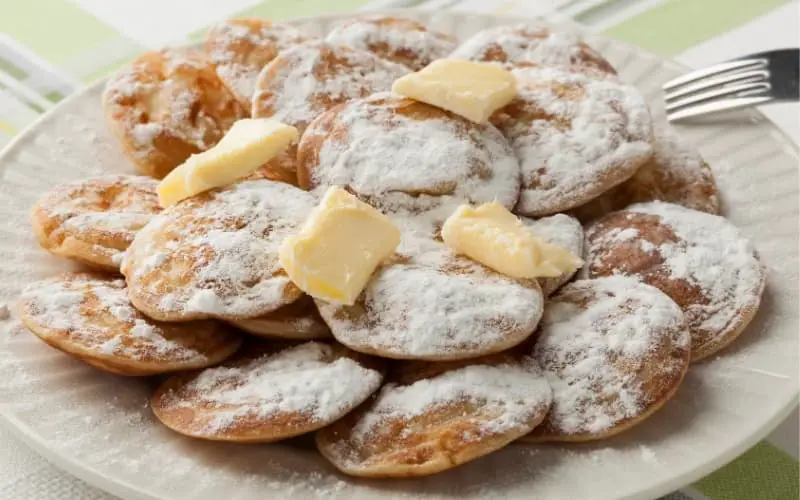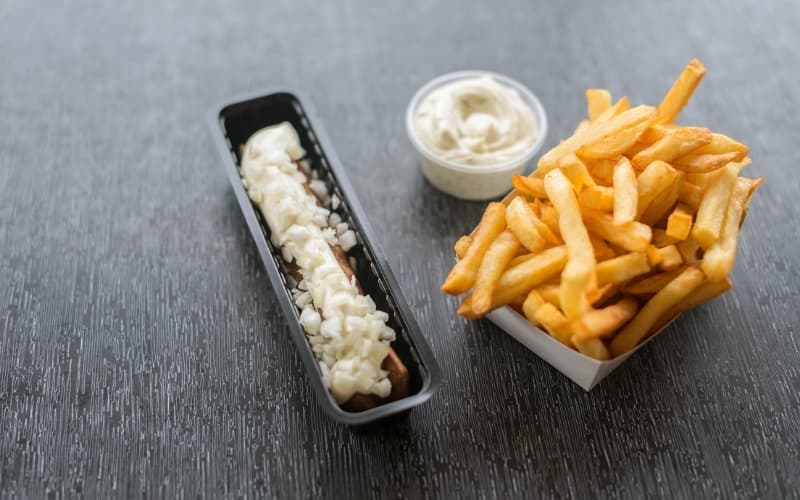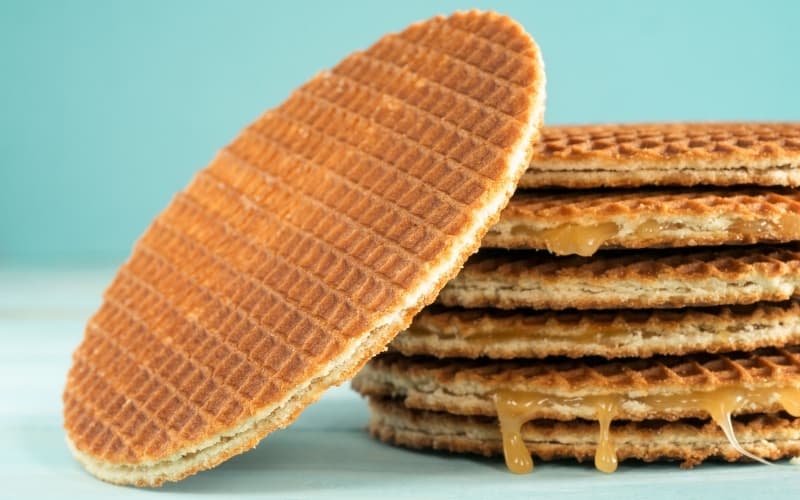

Like every country, the Netherlands has a unique cuisine, very different from its neighbors. Although not very popular internationally, the Dutch cuisine and food culture are very interesting.
In this article, I will tell you everything that makes the Dutch food culture so special. For example, you will find out what we eat in the Netherlands when a baby is born, but I will also explain that in the Netherlands you can get food from a machine in the wall.
Don't wait any longer and read below the 15 interesting Dutch food culture facts!
Everybody knows and loves them, pancakes! But, Dutch pancakes are quite a bit different from the ones you might have imagined. They are a lot thinner than American pancakes, but not as thin as French crêpes. They are typically covered in syrup or sugar and then rolled up.
But, the Dutch also eat another type of pancake. These are unique to the Netherlands and have therefore no translation. They are called poffertjes. These are very small pancakes that are quite thick. These are often served, with some powdered sugar and some butter, during various festivities, like funfairs or on Kings Day.
There is not a single Dutch person that dislikes poffertjes!

There are many different ways to eat your fries. Fries were originally invented in Belgium, but now they are being eaten everywhere around the world. There are French fries, Belgian fries, and even curly fries. But none of them are the same as Dutch fries.
Dutch fries are thinner than Belgian fries but thicker than French fries. Another big difference between Dutch and Belgian fries is what they are baked in. Originally, fries are fried in animal fat, but in the Netherlands, they are fried in sunflower oil. This makes them a lot less fatty than their Belgian counterparts.
Another thing that makes the way the Dutch eat fries so special, is what they eat with them. The Dutch have many so-called "snacks". There are too many of them to name, but here are a few, the "frikandel", “kroket”, “gehaktstaaf” (literally, a stick of minced meat), and the "cheese souffle".
All these typical Dutch snacks are prepared in a deep fryer like your fries are. When the Dutch eat fries, one of these snacks will be on their plate as well.
Next to the snacks, sauces are also added to the meal, mayonnaise being the most popular. Next to mayonnaise, there are many other sauces like ketchup, peanut sauce, and curry sauce.

The Netherlands might be small, but there are many differences between the various Dutch provinces. People from Zeeland might be even more brutally honest than most Dutch people and in Noord-Brabant and Limburg people celebrate carnival.
With such cultural differences, it is also quite logical that there are also a lot of regional dishes. Most dishes are a form of pastry. In Limburg, they eat "vlaaien" which are a type of flat fruit pies. Zeeland has their “bolussen” and in Groningen they have the “Groninger Sucadekoek”.
When visiting, do make sure to look up a few cultural facts about that specific region, so you can enjoy one of these fantastic regional dishes.
Many cultures have specific foods associated with holidays. A famous example of this is the turkey many Americans eat with thanksgiving.
The Dutch also have a unique celebratory food! But instead of it being a fancy dinner, the Dutch prepare their food themselves while sitting at the table. This way of eating is called “gourmetten”. Many Dutch families do this during Christmas and Easter.
When “gourmetting”, the Dutch all get little pans and place them on a heating plate that is on top of the table. With these little pans, they bake many different dishes for themselves while sitting at the table. Some popular dishes which are prepared are small omelets, potato wedges, small hamburgers, sausages, and vegetables.
Gourmetten was invented in Switzerland. There, they would bake small pieces of cheese on a big, heated stone. In the 1970s an association of butchers promoted this activity in the Netherlands, but instead of baking cheese, they suggested baking pieces of meat.
The meat sales had stagnated during that time, so the butchers we hoping that they could make some more money by inventing this activity. Quite soon after, “gourmetting” became really popular in the Netherlands and is now known as a Dutch tradition.
Most people probably only know orange carrots. That’s just how they are and always have been, right? Well, not exactly! The original carrot was found in modern-day Iran and brought to the Netherlands by traders. The crop was found to grow really well in the Netherlands. But, these carrots were white and purple, not orange.
In the 17th century, the Dutch experienced their golden age. To honor their country, their flag, and their Stadholder, they started to crossbreed carrots until they were orange and matched the national color.
The birth of a baby is a special occasion in every country, and every culture has its own traditions surrounding it. And so do the Dutch. Although there are not many, there is one that has stood the test of time. Whenever a new child is born, it is celebrated with rusk, topped with “muisjes”, a sweet topping made from anise seeds.
This topping also has some symbolism attached to it. The different colors of the seeds change depending on the gender of the newborn child. A pink and white topping is for a girl, blue and white for a boy.

Chocolate sprinkles are used in many different countries. Every country from France to China knows about them as a cake topping. The Dutch, on the other hand, put them on their bread.
But, people don’t limit themselves to just chocolate sprinkles as there are countless variations on the concept. From fruit-flavored sprinkles to chocolate flakes, from black and white sprinkles to oversized sprinkles, there is no end to the number of different types of sprinkles that the Dutch spread on their bread.
Most Dutch people don’t even go on vacation without bringing some sprinkles (or “hagelslag” as they’re called in Dutch) with them!
There are a lot of very special and unique dishes in Dutch cuisine, but most Dutch dishes are typically just reserved for special occasions. There is just one food combination that can, and in most families will, be served every single day, which is potatoes, vegetables, and meat!
The simplicity makes this dish so versatile. Every type of vegetable or meat can be used, and there are many ways you can prepare potatoes. In addition to that, it is also reasonably healthy. As long as you choose a healthy type of meat, and healthily prepare the food, all nutrients needed to live healthily are present.
And of course, when one plate is not enough, you just grab another plate! You will not get another piece of meat though.
MORE ABOUT DUTCH FOOD!
Would you like to know exactly what the Dutch eat? Then please check out the next article.
- What Do The Dutch Eat? The Complete Dutch Food Guide
Fast-food is a worldwide phenomenon. Wherever you go, you can get some food quickly and cheaply somewhere. Generally, this food is not the healthiest. The Dutch also have their own take on fast food, mainly consisting of fries.
But another thing often being served are the so-called “snacks”. These are small dishes, that vary greatly. The Dutch “kroket” and “frikandel” are great examples of this.
Normally, these snacks are ordered in a snackbar. But, it costs the store owner quite a bit to maintain such snackbars. And a physical shop can only serve that many customers at a time. In addition to that, you’d still have to wait a while before your snack has been prepared, which is very inconvenient if you are in a hurry.
The Dutch fast-food brand FEBO has found a solution for this. Instead of having a snackbar, they insert small little windows in a wall, with warmed compartments behind them. These are filled with snacks by an employee from the backside.
A customer can insert coins into the wall and select which snack they’d like, just like a vending machine. Then the door opens, and the customer can take out the snack.
This form of selling fast-food became very popular and spread quickly all throughout the country. Currently, the popularity of these doors has declined greatly. There are not a lot of places where you can “take a snack out of the wall”.
But, the very first and original FEBO is still existing though. It is located in the city center of Amsterdam and is operational to this day.
Every country has its own eating habits which they are known for. One of the eating habits the Dutch are known for is that they eat notoriously early! Traditionally, 6 pm is dinnertime, but there are also a lot of families that enjoy eating as early as 5 pm!
The exact reason for this cultural phenomenon is not exactly clear, but there are some theories. One has to do with the average Dutch workday, which lasts from 9 am until 5 pm. Many people just enjoy eating directly after they return home from work.
Most people in the Netherlands also do not eat a lot for lunch, causing them to be more hungry at the beginning of the evening. Another theory states that it is because many Dutch people have a lot to do in the evening. Eating late would simply be too impractical.
A snack that sometimes results in funny looks from foreigners, is herring. The funny looks are due to the fact Dutch people love to eat this fish raw. It can either be eaten with bread and onions or simply on its own.
There are some regional differences in how the herring is eaten as well. Each year, plenty of Dutch people look forward to the new herring season and when asked how the herring tastes, most of them will respond with "even better than last year". This is a bit of a tradition.
Another tradition is that the first keg of herring each season gets auctioned off for charity.

Licorice is a type of candy found in many countries, but the Dutch variant of it is special. The Dutch originally found licorice roots whilst trading for spices, of which they later made the candy we know nowadays.
What makes the Dutch licorice so different from other types? Well, to start off, the Dutch add way less sugar than most other cultures. This makes it way less sweet and lets the taste of the licorice root dominate. Secondly, Dutch licorice is often salted. The combination of sweet and salty licorice is not used in many other places.
Many Dutch people try to pull jokes on foreigners by offering them licorice, saying that it is just a normal candy. It has become well-known in the Netherlands that mostly just Dutch people enjoy Dutch licorice.
So be sure to watch out when a Dutch person offers you a black piece of candy, it might not be such a tasty treat as you might imagine. On the other hand, you might be one of the few non-Dutch people that do enjoy it.
Another thing the Dutch are famous for is their wide array of cheese. But in contrary to many other cheese-eating countries, cheese is used very differently in the Netherlands. Instead of being an appetizer or dessert, as in France for example, cheese has become a key component of Dutch meals.
Cheese can be found in almost every meal. One of the most remarkable uses of cheese is found around lunchtime. Many Dutch people like to eat a cheese sandwich for lunch, but the Dutch have a different idea of a sandwich compared to the rest of the world.
The Dutch cheese sandwich consists of two slices of bread, a thin layer of butter, and a few slices of cheese, that’s it. It is even considered appropriate to offer business partners this for lunch.
The Dutch are so into cheese that a Dutchman eats an average of 20 kilos of cheese per year!
These famous snacks or sweets are popular everywhere in the world. They are one of the best examples of Dutch food that has been able to convince the world of its tastiness.
Stroop waffles ("stroopwafels" in Dutch) originate from the Dutch city of Gouda, which is also well known for its cheese. Bakers had a lot of scraps left of their various baking activities. They started to use these scraps and sweetened them up with some syrup.
This newborn snack became so popular that bakers started baking more and more of them, and eventually, the Stroopwafels were born. The Dutch took them with them on their colonial travels and spread the waffle around the world.
Stroopwafels are also often given as gifts to foreign visitors, as most people simply love stroopwafels.

Although winters are not that cold anymore in the Netherlands, as they used to be. When cold is combined with physical labor, you get really hungry. That is why the Dutch have invented many types of food just for this season.
The most famous cold-weather meal is "stamppot" (or hotchpot in English). There are many types of stamppot, with some of the most famous being "hutspot" and "boerenkool".
These dishes are made by putting potatoes and some other ingredients into a big pot and mashing them until they are similar to how mashed potatoes are made. The result is a very nutritious and filling dish because of the potatoes, vegetables, and fatty meat. Traditionally the meal is served with smoked sausage or a meatball.
Very cold winters and heavy labor might have disappeared in the Netherlands for the most part, but "stamppot" remains an extremely popular dish, especially during winters.
MORE FACTS ABOUT THE NETHERLANDS!
Do you like facts? Then please check out our other articles with interesting facts about the Netherlands!
- 19 Interesting Dutch Windmill Facts (Fully Explained)
- 12 Best Amsterdam Canals Facts You Didn’t Know
- 54 Interesting Facts About The Netherlands (Fully Explained)
- 45 Interesting Facts About Amsterdam (Fully Explained)
- 38 Interesting Facts About Utrecht (Facts Fully Explained)
- 52 Amazing Facts About Rotterdam (Facts Fully Explained)
- 30 Facts About Sports In The Netherlands (Find Out Now)
- 46 Fascinating Facts About Dutch History (Find Out Now)
I hope this article has taught you many new things about Dutch food culture. As mentioned earlier, Dutch cuisine is not known internationally for its great food. But still, I hope to have made you curious about some Dutch dishes or snacks.
I definitely recommend you to try some of the above-mentioned products when you're on vacation in the Netherlands, and who knows, maybe you'll also like cheese on your sandwich, or can't do without delicious Dutch stroopwafels or licorice anymore.